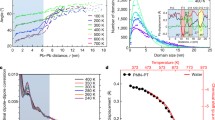Abstract
The central problem in the physics of relaxors is the nature of the polar nanoclusters. Whereas relaxors are homogeneous at high enough temperatures, polar nanoregions immersed in a neutral matrix are formed below a certain temperature T b . This should lead to a two component system. Here we present direct microscopic evidence for the two component nature of relaxors. We show that the chemical shift perturbed 207 Pb NMR spectra of these systems consist of an isotropic component corresponding to a spherical glassy matrix which does not respond to an applied electric field, and an anisotropic component, corresponding to frozen out polar nanoclusters which order in a strong enough electric field, forming a ferroelectric phase. This is as well reflected in the dynamic properties where the relaxation time distribution function starts to become asymmetric with decreasing temperature and a second maximum—which is never seen in dipolar glasses and is obviously due to polar clusters—appears on further cooling. We also show that the basic difference between dipolar glasses and relaxors is the fact that polar nanoclusters can be oriented in a strong enough electric field and a ferroelectric phase can be induced. This is not the case in dipolar glasses where the response is due to single dipoles which can not be ordered by applied electric fields.
Similar content being viewed by others
References
G. A. SMOLENKSY, J. Phys. Soc. Jpn. (Suppl.) 28 (1970) 26.
L. E. CROSS, Ferroelectrics 76 (1987) 241.
H. FU and R. E. COHEN, Nature 403 (2000) 281.
G. BURNS and F. H. DACOL, Phys. Rev. B 28 (1983) 2527.
D. VIEHLAND, J. F. LI, S. J. JANG, L. E. CROSS, and M. WUTTIG, Phys. Rev. B 43 (1991) 8316.
T. EGAMI, E. MAMONTOV, W. DOMOWSKI, and S. B. VAKHRUSHEV, in “Fundamental Physics of Ferroelectrics,” edited by P. K. Davies and D. J. Singh, American Institute of Physics, CP 677 (2003) 48.
J. BANYS, unpublished work from this laboratory.
S. B. VAKHRUSHEV and N. M. OKUNEVA, AIP Conf. Proc. 626 (2002) 117.
R. PIRC and R. BLINC, Phys. Rev. B 60 (1999) 13470.
R. BLINC et al., Phys. Rev. Lett. 63 (1989) 2248.
R. BLINC, V. V. LAGUTA and B. ZALAR, Phys. Rev. Lett 91 (2003) 247601.
R. BÖTTCHER et al., Phys. Rev. B 62 (2000) 2085.
Author information
Authors and Affiliations
Corresponding author
Rights and permissions
About this article
Cite this article
Blinc, R., Laguta, V.V., Zalar, B. et al. Polar nanoclusters in relaxors. J Mater Sci 41, 27–30 (2006). https://doi.org/10.1007/s10853-005-5914-8
Issue Date:
DOI: https://doi.org/10.1007/s10853-005-5914-8




